Frequently Asked Questions About Venomous Snakes
What are my chances of dying from a venomous snakebite? How much venom is in a snake? What snake venom is most toxic? Below are the answers to these questions and more. If you have a question that is not answered here, contact Dr. J for more info.
What are my chances of being
bitten by a venomous snake in the U.S.?
How many people die each year from venomous snake bites?
The chances of dying from a venomous snakebite in the United States is nearly zero, because we have available, high-quality medical care in the U.S. Fewer than one in 37,500 people are bitten by venomous snakes in the U.S. each year (7-8,000 bites per year), and only one in 50 million people will die from snakebite (5-6 fatalities per year). Did you know that you are nine times more likely to die from being struck by lightning than to die of venomous snakebite? The graph below compares deaths from venomous snakebites to some leading causes of death, lightning strikes and other animal related deaths.
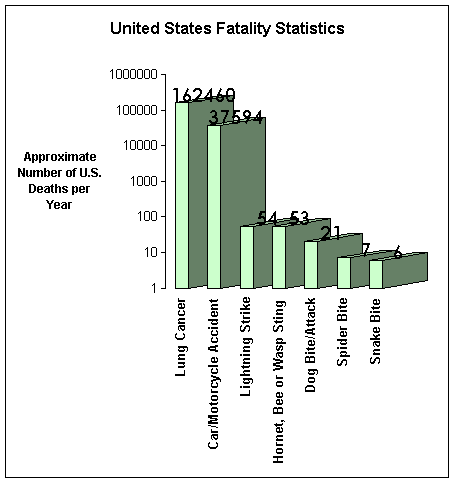
What is the difference between
poison and venom?
If you drink venom, will it kill you?
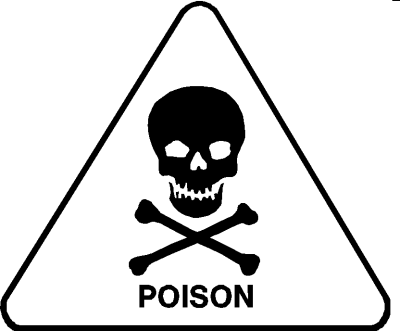 Poisons
are substances that are toxic (cause harm) if swallowed or inhaled.
Venoms are generally not toxic if swallowed, and must be injected
under the skin (by snakes, spiders, etc.) into the tissues that are normally
protected by skin in order to be toxic. However, we do NOT recommend
drinking venom!
Poisons
are substances that are toxic (cause harm) if swallowed or inhaled.
Venoms are generally not toxic if swallowed, and must be injected
under the skin (by snakes, spiders, etc.) into the tissues that are normally
protected by skin in order to be toxic. However, we do NOT recommend
drinking venom!
How big is the venom gland and where is it located?
 The
venom gland is a modified salivary gland, and is located just behind
and below the eye. The size of the venom gland depends on the size of
the snake - this image shows the approximate size of the venom gland
in relation to the skull of this Timber Rattlesnake (Crotalus
horridus).
The
venom gland is a modified salivary gland, and is located just behind
and below the eye. The size of the venom gland depends on the size of
the snake - this image shows the approximate size of the venom gland
in relation to the skull of this Timber Rattlesnake (Crotalus
horridus).
How much venom is in a snake?
The amount of venom in a snake’s venom gland (measured as the amount extracted by milking) increases exponentially with the size of the snake, and can range from 1 – 850mg (or more). In a study comparing snake venoms, researchers milked the largest amount of venom from an Eastern Diamondback Rattlesnake (Crotalus adamanteus)--more than from any other species they studied.
What snake venom is most toxic drop for drop (LD50) in the US? Globally?
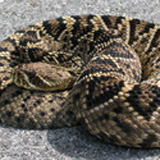 A
comparative study found that the snake venom that is most toxic to mice (of
the species tested) is that of the Inland Taipan (Oxyuranus microlepidotus),
found in Australia. The most toxic venom of U.S. species belongs to the Eastern Diamondback Rattlesnake
(Crotalus adamanteus), although this snake is only ranked #23 on the
list of most toxic venoms. It is important to note
that these venoms were only tested on mice. While these tests
provide valuable ecological information about venomous snakes that eat mice and
other small mammals, it may not accurately reflect how toxic they are to humans.
The world's deadliest snake
is probably the Saw-scaled Viper (Echis carinatus), because
it causes the most documented deaths. However,
many of these deaths are likely due to lack of medical care.
A
comparative study found that the snake venom that is most toxic to mice (of
the species tested) is that of the Inland Taipan (Oxyuranus microlepidotus),
found in Australia. The most toxic venom of U.S. species belongs to the Eastern Diamondback Rattlesnake
(Crotalus adamanteus), although this snake is only ranked #23 on the
list of most toxic venoms. It is important to note
that these venoms were only tested on mice. While these tests
provide valuable ecological information about venomous snakes that eat mice and
other small mammals, it may not accurately reflect how toxic they are to humans.
The world's deadliest snake
is probably the Saw-scaled Viper (Echis carinatus), because
it causes the most documented deaths. However,
many of these deaths are likely due to lack of medical care.
What percent of bites are dry
bites (no venom injected)?
Can all venomous snakes deliver a dry bite?
Venom delivery is voluntary -- snakes squeeze their venom blands with muscles to deliver venom. All venomous snakes could deliver dry bites. Estimates show that 20-25% of all pit viper bites and 50% of Coral Snake bites are dry bites. Occasionally, the venom may be prematurely expelled from the fangs before they puncture the skin, which can also result in a dry bite.
Have there been any reported deaths from a Pygmy Rattlesnake bite?
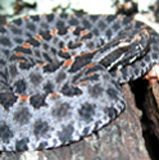 No, there are no reported deaths from a Pygmy Rattlesnake on record.
No, there are no reported deaths from a Pygmy Rattlesnake on record.
However, in certain cases or situations (victim is very young or
elderly,
no medical care accessible), fatality could occur.
Where did the venomous Cottonmouth,
also known as the Water Moccasin, get its name?
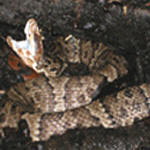 The
name 'Cottonmouth' comes from the defensive behavior of this snake.
When threatened, the snake will coil its body and open its mouth to
show the white, cotton-colored inside as a warning. Although there are
several theories about the name 'Water Moccasin', no one knows for
sure where these snakes got this name. Early settlers may have called
the Cottonmouth and the closely related Copperhead "Moccasins" due to
their brown, "moccasin-colored" skin, or due to the fact that these
pit vipers lack rattles, moving as silently as the moccasin-wearing
native Americans.
The
name 'Cottonmouth' comes from the defensive behavior of this snake.
When threatened, the snake will coil its body and open its mouth to
show the white, cotton-colored inside as a warning. Although there are
several theories about the name 'Water Moccasin', no one knows for
sure where these snakes got this name. Early settlers may have called
the Cottonmouth and the closely related Copperhead "Moccasins" due to
their brown, "moccasin-colored" skin, or due to the fact that these
pit vipers lack rattles, moving as silently as the moccasin-wearing
native Americans.
Back to Dealing with Snakes